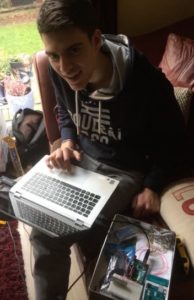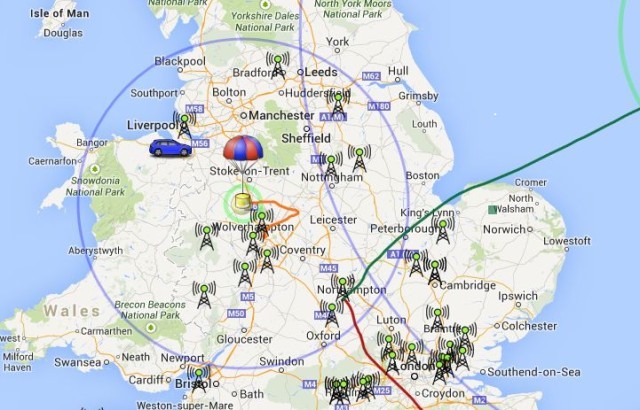How To Build A Weather Balloon Space Camera
Writer: Jacob Smith -
Hello! I'm Jacob, a Mechanical Engineering student currently on placement at Airbus Defence and Space in Stevenage, UK. I take ever been interested in space, and having finally been reintroduced to the idea of 'my ain free time', I decided to fulfil my dream of sending something into infinite. That thing – a box on a very big balloon…

Launching a High Altitude Balloon (HAB) is a surprisingly popular hobby, especially in the U.k., having been termed the 'poor man's infinite plan'. It involves sending a payload – ordinarily a polystyrene box containing a photographic camera and a tracking device at minimum, to altitudes of about 30km on a weather airship. Technically this is an area called near infinite (up to 100km) not infinite (above 100km). My main aim is to capture video and images of the beautiful globe against the black backdrop of space. I will be so happy if I can pull this off!
The Basics
Before I outset talking nigh everything I volition have to practise, I would but like to requite a bones thought nearly how flights piece of work and listing a few things that tin can brand them challenging, helping you understand my decisions throughout the project
- A big balloon made of highly flexible latex is filled with either Helium (more expensive) or Hydrogen (don't – it'south a lot more flammable). Both these gases are lighter than air then volition elevator the payload off the ground. As the balloon rises it increases in diameter due to the subtract in air pressure, until it bursts. The parachute, fastened between the balloon and payload, volition then open slowing downwardly the descent of the payload.

Bones fix-upwardly of a High Altitude Balloon - Temperatures can get down to -60°C making it of import to select suitable components and thoroughly test them.
- It is vital to await for the right weather and get permission from the Civil Aviation Authorities. I hope to exist ready to launch in the summer when there is less risk of stiff winds conveying the balloon into the sea or even beyond. You lot wouldn't want to lose all your hardware.
Research, enquiry, and more than research
I spent a few weeks reading about and existence inspired past similar projects that other people have done, learning about the systems and components required, and determining if I could really do this. Flights can vary greatly in complexity and hence time and price. Considering this is the get-go fourth dimension I am doing annihilation like this I decided to keep it simple which will go along the price and chance of it going wrong relatively low. I am, however, wanting to learn new skills in conveying out this project, then I volition be doing everything myself and not buying pre-made kits.
Without a working tracking system there is no way of finding the payload once information technology lands and retrieving those Earth images you take worked so hard to go. For this reason, I decided to first create a reliable tracker, otherwise there was no point in doing everything else.
There are a few general options when tracking a HAB flying in the Great britain.
1. Mobile phone or GPS/GSM trackers
Cheap and elementary mobile phone and GPS/GSM trackers will send you their electric current location when you transport a text to/call the number. It didn't take much time to rule out using these methods, having to rely on landing somewhere where the device can option up a signal, assuming it is notwithstanding operating later on a couple of hours in extreme temperatures, is a risk I exercise non want to have. They would merely accept indicate close to the ground, up to a few 100m, so without the ability of live in-flying tracking I would have to wait for it to land before I had any idea where information technology was.
2. SPOT tracker
SPOT trackers, intended for use mainly past hikers should they get into trouble, are quite a pop choice for HAB flights. They use a different satellite network to GSM so will piece of work up to a greater altitude of 12km, only this even so covers less than half the target altitude. SPOT trackers only work when facing towards the heaven, a problem if the payload box were to coil over on landing, and are quite expensive due to the yearly service fee required to really use the device.
iii. UKHAS (UK Loftier Distance Guild) Tracking Organisation
The UKHAS Radio Tracker arrangement is a system adult in the UK and is the recommended and about widely used amongst HAB hobbyists. An onboard tracker picks up its current position and a radio module transmits information technology downward to antennas on the ground. The nifty matter well-nigh this is the extensive network of listening stations i.east. anyone with a suitable antenna can become the location and automatically upload it to a central server, helping you rail your flight (run across image below). Trackers are available to buy online, but for a much more rewarding project, you can create your own. This is what I decided to do…

A way forward
If washed correctly, this will be the about reliable tracking method. To receive a point y'all need line of sight from your payload transmitter to your receiver on the ground. There is no doubt that this is the best method as signals have been received up to 400km abroad! Having never really been interested in electronics and armed with but a very basic knowledge, this would be the hardest part for me. Just I was nifty to acquire virtually and develop an understanding of electronic systems. I am very grateful for the guides available on the UKHAS website.
I am excited to start this project and at present have a clearer direction of how I volition carry it out. I accept a listing of the components I will demand, and at present merely need to find and order them. I hope you have enjoyed reading nearly my idea, and that yous volition follow my journey to nigh space. I am happy to respond any questions in the comments below. In my side by side post I will describe how I will get about building my radio tracking organisation.
Source: https://blogs.bath.ac.uk/engdes-student-insights/2018/02/13/launching-a-camera-to-the-edge-of-space-an-introduction/
Posted by: brucesiderear.blogspot.com

0 Response to "How To Build A Weather Balloon Space Camera"
Post a Comment